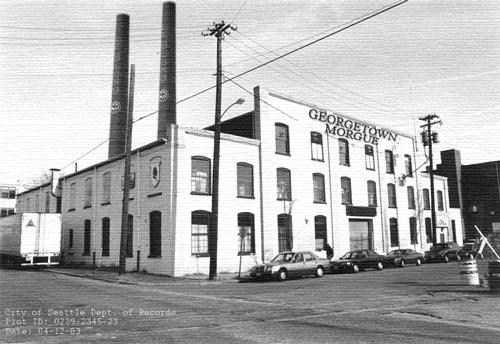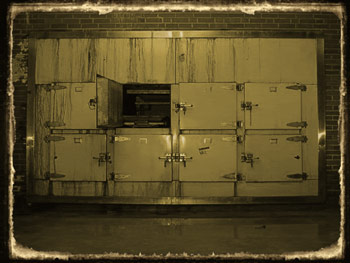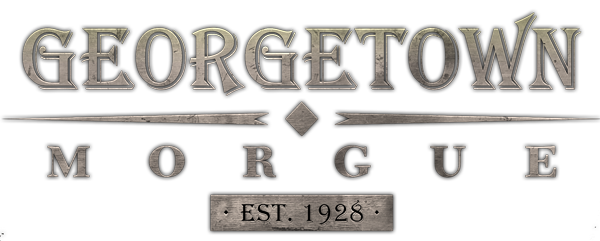Morgue History
THE GEORGETOWN MORGUE (1928-1983)
Author: James Henrikson
February 12, 2000
 The Georgetown Morgue Historic Society
The Georgetown Morgue Historic Society
The next morgue on our list is the Georgetown Morgue, which stands out among historic morgues, not for its unusual industrial surroundings, but for what can only be described as a series of colorful (albeit at times horrifying) events in its relatively short (and fairly recent) history.
The Georgetown Morgue, 1983
Some people have questioned why this little-known morgue made the Historic Morgue Society’s “Most Intriguing Historic Urban Morgues” list in 1999, but with a little background, the reader should have no problem understanding why.
The History of the Morgue in Seattle
History of the Georgetown Morgue:
Built: 1928
Original Name: Kolling Mortuary Services of Seattle
Original Owner: Scottland Timothy Kolling
Original Purpose: Processing and preparation of the deceased.
Kolling Mortuary Services of Seattle constructed the 3-story facility in 1928 as a single-purpose funeral preparations facility.
Change of Ownership: 1939
New Name: Broughton Brothers Funeral Services
Owner: Charles and Henry Broughton


Owners Charles and Henry Broughton, 1946 – From Seattle Times archives
The Broughton Brothers (pictured left) purchased the facility in 1939 with more ambitious plans, transitioning it from a simple funeral preparations home to, by 1943, a 100-body-per-day Crematorium. The extended facilities were erected from the South-facing wall, including two 110-foot smoke stacks (approved by the City of Seattle but not without some degree of public outcry, see * below). In addition: Charles Broughton built a small brick home on the west side of the property, where it remains to this day.
Kolling Morgue of SeattleOn April 29th, 1965 a 5.7 magnitude earthquake rocked the Puget Sound area, and while other businesses in Seattle suffered only moderate damage, tragedy struck the Broughton Brothers when crematorium Tower 1 collapsed into the west side of the building, taking out the upper floor, and killing Charles Broughton.
Brother Henry Broughton continued the business, and necessary structural renovations included the removal of the third floor. Tower 1 was rebuilt in 1967.
Change of Ownership: 1969
New Name: The Georgetown Morgue
Owner: City of Seattle
City of Seattle’s Georgetown Morgue, 1976
The City of Seattle acquired the facility after Broughton Brothers Funeral Services defaulted on their loan. (See the bizarre backstory on that below.) Once again, the facility underwent a significant change: the City converted it to a morgue. At that time, the area was part of the Georgetown District, and the City chose the Georgetown Morgue as a suitable name. Interesting sidenote: the City did not abandon the crematorium part of the facility, and instead continued to utilize it, although this time for the purpose of processing animal carcasses for their Animal Control Department.
The City operated the Georgetown Morgue until 1983, when a modern morgue was erected in Downtown Seattle at 5th Ave S. and Seneca Street. The City offered the property for sale, but received no interested buyers until 1989 (perhaps due in part to its intriguing albeit morbid history — see * below).
Change of Ownership: 1989
Owner: Richland Processing Corp.
The Richland Processing Corporation purchased the facility from the City of Seattle with the intention of converting it to a meatpacking transfer station. They sold crematorium towers 1 & 2 to nearby Simmons Foundry Works, where they were relocated in 1990.
The Building Today:
Home of the late Mrs. Charles Broughton
The building has undergone significant structural change and bears only a slight resemblance to the former Georgetown Morgue. As of the time of this writing, the footings of the former crematorium smoke stack towers are still evident along the South-facing wall of the Richland Processing facility. The adjacent brick home of Charles Broughtonb,”s widow (who remained at the residence until she claimed her own life in 1979) remains. At the time of this writing, Richland still operates the meat packing transfer station.

The Fascinating Historic Backstory of the Georgetown Morgue…
The Georgetown Morgue had a strikingly colorful 43-year history as a funeral preparations home, crematorium and morgue. City of Seattle public records, Police Department records, and Seattle Times microfiche records paint a colorful and — at times — horrifying picture. We will summarize a few of the more intriguing events below.
1940’s jazz great John “Figgy” Dorsey:
When jazz trumpeter and nationally-acclaimed band leader John “Figgy” Dorsey died in 1947, he was brought to Broughton Brothers for funeral preparations. At this point, events turned horrific. According to police reports, Charles Broughton reported a break-in to the facility, and during the police inquiry, the body of Mr. Dorsey was discovered to be missing from the embalming procedure table. The following morning came the gruesome discovery by Mr. Dorsey’s wife of her late husband’s dismembered body (details not included in this article) on the front lawn of her home at 5465 Eldridge Ave. in Ballard. Not to be deterred, Mrs. Dorsey had the body returned to Broughton Brothers Funeral Services to be reconstructed for public viewing at his funeral. Media reports at the time were sensational, making for an even higher profile burial of the already high profile musician.
“Seattle Crematorium Massacre” followed by the Change of Ownership to City of Seattle, 1969:
The transfer of ownership from Broughton Brothers Funeral Services to the City of Seattle in 1969 followed one of the most gruesome crimes on record. Coined at the time by the Seattle Times as the “Seattle Crematorium Massacre,” there has been a great deal of unresolved speculation as to exactly what occurred during the evening of October 25, 1968:
Haunted Seattle Halloween
On that evening, during a business meeting on the premises, 2 (perhaps 3) suspects (assumed to have been armed), entered the building and forced all 9 attendees (the entire facility staff of Broughton Brothers Funeral Services, including company owner Henry Broughton) to be bound. In what is considered to be the most horrifying unsolved crime in Seattle history, each attendee was forced into the crematorium chamber. There were no surviving witnesses, nor were suspects ever identified. This crime is unique in its nature. Speculation has always abounded in regard to motive, but character witness testimony on police record does indicate a suspicion of less-then-legitimate business practices at Broughton Brothers.
 As a result of the crime, Broughton Brothers Funeral Services had no living employees. Broughton family members had no choice but to foreclose on its loan, at which point the City of Seattle acquired the facility.
As a result of the crime, Broughton Brothers Funeral Services had no living employees. Broughton family members had no choice but to foreclose on its loan, at which point the City of Seattle acquired the facility.
* Public outcry over the construction of the two 140-foot smoke stacks (1943):
The industrial boom of the early 1940’s to support the war, while critical for the nation’s production of needed materials, did have the unwanted effect of contributing to some of the worst air quality in the nation. Seattle citizens groups took interest in preserving air and water quality in the Puget Sound area. The sensational nature of the proposed crematorium smokestacks made for high profile headlines. However, the City of Seattle eventually approved the construction of the stacks in 1943, and the project was completed and in production by 1945.
The Georgetown Morgue ranked number 4 in the Historic Morgue Society’s “Most Intriguing Urban Historic Morgues” list in Sept., 1999.





